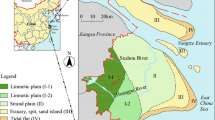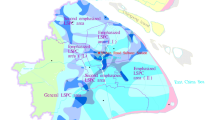Abstract
Subway foundation pit dewatering may contribute to the regional land subsidence in a built-up area when aquifers are too thick to be cut off by a curtain. The land subsidence induced by subway foundation pit dewatering was divided into local subsidence and areal subsidence. The former was managed by construction organizations, while the latter was managed by a land resource, urban management, and hazard prevention department. The areal subsidence could not be recovered after dewatering because of its vast influence area and contribution to regional land subsidence. The boundary between local subsidence and areal subsidence was defined as the location of three times the foundation pit depth to the foundation pit boundary. The subsidence within the boundary belonged to local subsidence, whereas the subsidence outside the boundary belonged to areal subsidence. With Shanghai as background, the conceptual and mathematical models that considered hydrogeological conditions, curtain depth, and pumping well screens were established, and numerical simulations were performed. When the pumping well screens were enveloped by a diaphragm wall, the best vertical distance of about 1.0–4.0 m was obtained between the screen bottoms and curtain bottom. The decreasing rate of areal subsidence was the highest under the interaction of diaphragm wall and pumping well screens. Further increasing the penetration depth of the diaphragm wall and shortening the length of the pumping well screen were both less efficient.











Similar content being viewed by others
References
Abidin HZ, Andreas H, Gumilar I, Fukuda Y, Pohan YE, Deguchi T (2011) Land subsidence of Jakarta (Indonesia) and its relation with urban development. Nat Hazards 59:1753–1771
Barends FBJ, Brouwer FJJ, Schroder FH (1995) Land subsidence: natural causes, measuring techniques, the Groningen gasfields. IAHS Press, Wallingford
Calderhead AI, Therrien R, Rivera A, Martela R, Garfiasd J (2011) Simulating pumping-induced regional land subsidence with the use of InSAR and field data in the Toluca Valley, Mexico. Adv Water Resour 34:83–97
Chen CX, Pei SP, Jiao JJ (2003) Land subsidence caused by groundwater exploitation in Suzhou City, China. Hydrogeol J 11:275–287
Chen CH, Wang CH, Hsu YJ, Yu SB, Kuo LC (2010) Correlation between groundwater level and altitude variations in land subsidence area of the Choshuichi Alluvial Fan, Taiwan. Eng Geol 115:122–131
Dassargues A, Zhang J (1992) Land subsidence in Shanghai: hydrogeological conditions and subsidence measurements. Bull Eng Geol Environ 46:27–36
Feng QY, Liu GJ, Meng L, Fu EJ, Zhang HR, Zhang KF (2008) Land subsidence induced by groundwater extraction and building damage level assessment—a case study of Datun, China. China Univ Mining Technol 18:556–560
General Administration of Quality Supervision, Inspection and Quarantine of the People’s Republic of China (GAQSIQ), Ministry of Housing and Urban-Rural Development of the People’s Republic of China (MOHURD) (2000) Code on geotechnical investigations for metro and light rail transit (GB 50307-1999). China Planning Press, Beijing
Hu R, Yue ZQ, Wang LC, Wang SJ (2004) Review on current status and challenging issues of land subsidence in China. Eng Geol 76:65–77
Hung WC, Hwang C, Liou JC, Lin YS, Yang HL (2012) Modeling aquifer-system compaction and predicting land subsidence in central Taiwan. Eng Geol 147–148:78–90
Larson KJ, Başaǧaoǧlub H, Marino MA (2001) Prediction of optimal safe ground water yield and land subsidence in the Los Banos-Kettleman City area, California, using a calibrated numerical simulation model. J Hydrol 242:79–102
Li CJ, Tang XM, Ma TH (2006) Land subsidence caused by groundwater exploitation in the Hangzhou-Jiaxing-Huzhou Plain, China. Hydrogeol J 14:1652–1665
Ministry of Housing and Urban-Rural Development of the People’s Republic of China (MOHURD) (1999) Technical code for groundwater lower in engineering in building and municipal (TCGLEBM) (JGJ/T111-98) (1999). China Architecture & Building Press, Beijing
Sarychikhina O, Glowacka E, Mellors R, Vidala FS (2011) Land subsidence in the Cerro Prieto Geothermal Field, Baja California, Mexico, from 1994 to 2005. J Volcanol Geotherm Res 204:76–90
Shanghai Geological Environmental Atlas Editorial Board (SGEAEB) (2002) Shanghai geological environmental atlas. Geological Publishing House, Beijing (in Chinese)
Shanghai Institute of geological survey (SHGS) (2014) http://www.sigs.com.cn/sigsonlines/. Accessed 22 Sept 2012
Shanghai Urban Construction Design & Research Institute (SUCDRI) (2008) Geotechnical Engineering investigation report of Hanzhong Road Station, Shanghai Subway line 12 (detailed investigation)
Shen SL, Xu YS (2011) Numerical evaluation of land subsidence induced by groundwater pumping in Shanghai. Can Geotech J 48:1378–1392
Shi XQ, Xu HH, Sun YY, Yu J (2012) Sustainable development and utilization of groundwater resources considering land subsidence in Suzhou, China. Eng Geol 124:77–89
Thomas LH, Johnson AI (1985) Land Subsidence caused by ground water withdrawal in urban areas. GeoJournal 11(3):245–255
US Geological Survey (USGS) (2003) MODFLOW-2000, the US Geological Survey Modular Ground-Water Model—Documentation of the SEAWAT-2000 Version with the Variable-Density Flow Process (VDF) and the Integrated MT3DMS Transport Process (IMT) Tallahassee, Open-File Report 03-426, Florida 2003
Wang CY, Huang LX, Duan WC, Yu YF (2006) Determination of coefficient Ms during calculation of surrounding ground settlement due to foundation pit dewatering. Rock Soil Mech 27:1011–1016 (in Chinese)
Wang JX, Hu LS, Wu LG, Tang YQ, Zhu YF, Yang P (2009a) Hydraulic barrier function of the underground continuous concrete wall in the pit of subway station and its optimization. Environ Geol 57:447–453
Wang JX, Wu LG, Zhu YF, Tang YQ, Yang P, Lou RX (2009b) Mechanism of dewatering-induced ground subsidence in deep subway station pit and calculation method. Chin J Rock Mech Eng 28:1010–1019 (in Chinese)
Wang JX, Feng B, Liu Y, Wu LG, Zhu YF, Zhang XS, Tang YQ, Yang P (2012a) Controlling subsidence caused by de-watering in a deep foundation pit. B Eng Geol Environ 71:545–555
Wang JX, Wu YB, Zhang XS, Liu Y, Yang TL, Feng B (2012b) Field experiments and numerical simulations of confined aquifer response to multi-cycle recharge-recovery process through a well. J Hydrol 464–465:328–343
Wang JX, Feng B, Guo TP, Wu LG, Lou RX, Zhou Z (2013a) Using partial penetrating wells and curtains to lower the water level of confined aquifer of gravels. Eng Geol 161:16–25
Wang JX, Feng B, Yu HP, Guo TP, Yang GY, Tang JW (2013b) Numerical study of dewatering in a large deep foundation pit. Environ Earth Sci 69:863–872
Xu XJ, Li DX (2004) Study on calculating method of ground subsidence caused by pit-dewatering. Geotech Eng Tech 18:194–198 (in Chinese)
Xu YS, Ma L, Shen SL, Sun WJ (2012) Evaluation of land subsidence by considering underground structures penetrated into aquifers in Shanghai. Hydogeol J. doi:10.1007/s10040-012-0892-9
Yi LX, Zhang F, Xu H, Chen SJ, Wang W, Yu Q (2011) Land subsidence in Tianjin, China. Environ Earth Sci 62:1151–1161
Zhang LH, Li RQ, Liu DF (2001) The calculation of effective stress and settlement based on the variable total stress in pit dewatering. Chin J Geol Hazard Control 12(66–67):77 (in Chinese)
Acknowledgments
I must show my respect to the editors and anonymous reviewers for their detail and patient work to my manuscript. This work is supported by the research grant (No. 201311045-04) from the Special Fund for Land and Resources-scientific Research in the Public Interest of China, CCCC Key Lab of Environment Protection & Safety in Foundation Engineering of Transportation, GDUE Open Funding (SKLGDUEK1417), LSMP Open Funding (KLLSMP201403, KLLSMP201404), the National Natural Science Foundation of China (No. 41072205), the Key Discipline Construction Program of Shanghai (Geological Engineering, No. B308) and the Foundation of China Railway No. 2 Engineering Group Co., Ltd. (No. 201218).
Author information
Authors and Affiliations
Corresponding author
Rights and permissions
About this article
Cite this article
Wang, J., Wu, Y., Liu, X. et al. Areal subsidence under pumping well–curtain interaction in subway foundation pit dewatering: conceptual model and numerical simulations. Environ Earth Sci 75, 198 (2016). https://doi.org/10.1007/s12665-015-4860-2
Received:
Accepted:
Published:
DOI: https://doi.org/10.1007/s12665-015-4860-2




